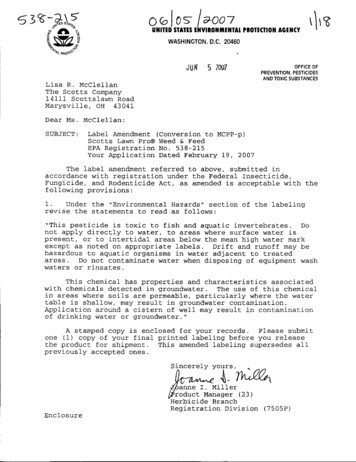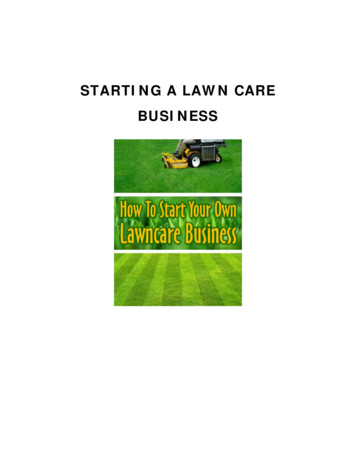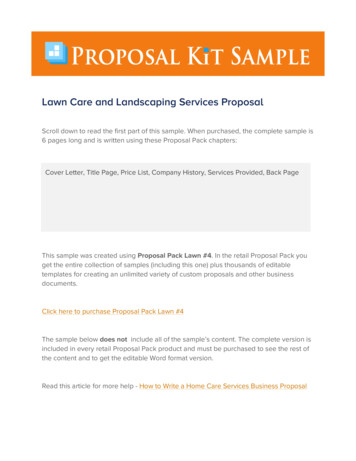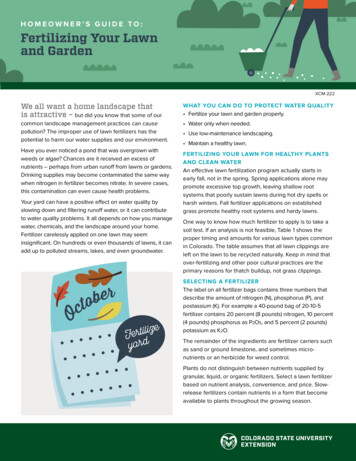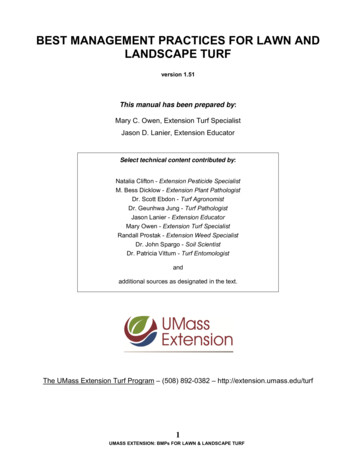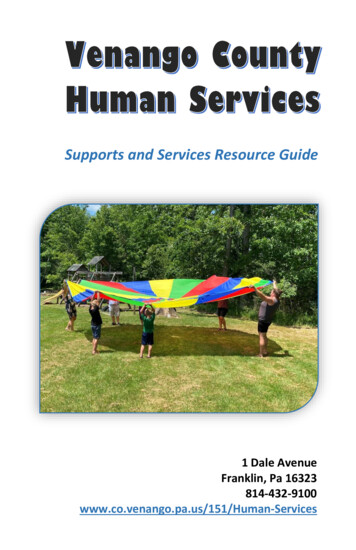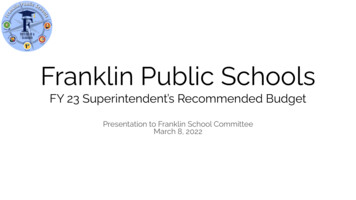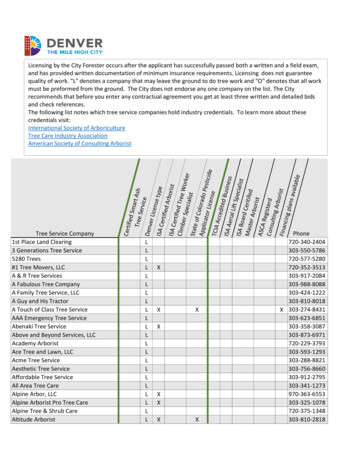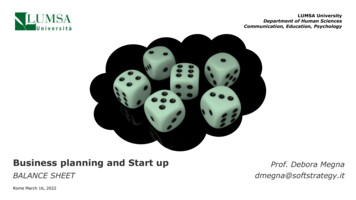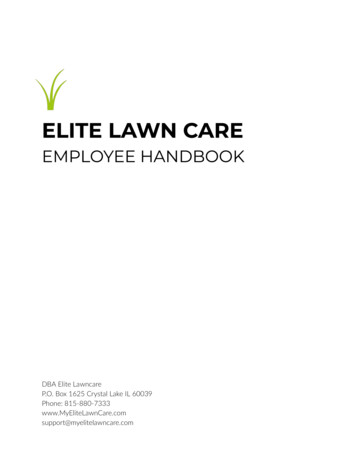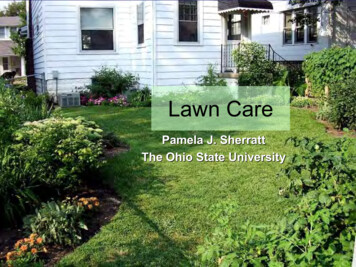
Transcription
Lawn CarePamela J. SherrattThe Ohio State University
Terminology – it’s confusing!Organic, natural, sustainable Pesticide Biopesticide Organic pesticideChemical (118 elements, compounds etc.)Fertilizer (natural and synthetic – organic?)
It’s a Personal Choice- Not Mandated in OH -
Both of these lawns are pesticide-free!
BESTMANAGEMENTPRACTICES (IPM)Pest, Diseaseand WeedManagementTurfgrassMaintenanceFertility * Mowing * Irrigation * Grass SelectionThatch Management * Core Cultivation *Healthy Soil
IMPROVING SOIL HEALTH
Soil Tests Measurement of plant available nutrientstatus of the soil– Identifies nutrient deficiencies– Predicts nutrient requirements Can detect nutrient imbalances, excesssalts Other factors (CEC, OM level, pH)
When to Sample Perform every 2-3 years on soil– Perform yearly on high sand ( 85%)– Be consistent with sampling procedure Timing - spring or fall– Prior to fertilization– Sample at same time of year
Grass won’t grow in poor,compacted soil
Aeration
TARGET 12 – 15 holes per sq.ft.
Thatch Control
- Topdressing Filling in holes & undulations Topsoil Compost & topsoil 0.25” – 3/8” depth, or as needed
Composts Yard waste Biosolid Spent mushroomcompost Manures Food waste www.findacomposter.com
Choosing a compost, physical& chemical propertiesColorBrown to blackOdorLike earthParticle size for topdressing¼ to 3/8 inchMoisture content30 to 50%Organic matterGreater than 30%Ash contentless than 70%c/n ratioBelow or equal to 30:1Nitrogen0.5 to 3%PhosphorusGreater than 0.2%pH6.0-7.0MetalsDetermined by state or federal agenciesSoluble saltsDepending on turf species, type of salt,concentration, and application methodRef: Penn State Plant Science, Using Composts to Improve Turf Performance
Application of biosolid compost topdressing @ 0.25” depth
Renovation: Killing the lawn & starting again Soil cultivation Using covers
The main advantagesto renovation: Better grassselection Soil amendment &re-grading Nutrient statuscorrection
Adding Compost
Right Grass, Right PlaceTall & fine fescuesKentucky bluegrassPerennial ryegrass
IONRAMBOBARONETTEBARRISTERDLFIMPACTTOTAL ECLIPSEA96-739AWARDJEFFERSONARCADIAPERCENTGENETIC SPRING COVERCOLOR .36.36.75.75.75.3QUALITY 4336665.95.95.95.85.85.85.85.85.75.75.75.6
Tall Fescue (Festuca arundinacea)
OLD type – “Kentucky 31”
IMPROVED/TURF-TYPE TALL FESCUE
WEAR TOLERANCE
Wear tolerant Drought resistant Endophytes Low maintenance
Best in Shade
Best for Low Input LawnsKentucky BluegrassTall Fescue
Best in Drought
Brown Patch Disease(Rhizoctonia solani)
Fine Fescue (Festuca sp.)
Tolerates, poor soils, poorfertility, & shade
Poor wear toleranceDormancy in hot weatherSusceptible to some diseases
Kentucky Bluegrass (Poa pratensis)Rhizome
Kentucky bluegrass dormancy during drought
NOT SHADE TOLERANT
KENTUCKY BLUEGRASSCan survive 6-8week droughtHydrated crown?
Kentucky BluegrassTall Fescue
PERENNIAL RYEGRASS(Lolium perenne)
USES:Mixed with Kentucky bluegrass50:5080:2075:25
5 days after seeding
20 days afterseeding
Can compete with spring weeds (crabgrass)
DisadvantagesNo. 1: Diseases
Brown PatchPythiumRustRed ThreadDollar Spot
Avoid annual (Italian) ryegrass
Beware annual ryegrass!
Annual ryegrass in July
When to Seed Cool Season TurfDifficultWith OrganicIdeal
Spring Seeding: NoWeed Control
Fall Seeding of Cool Season Turf August 15 – September 15– Turfgrasses are more competitive– Warm season weeds (e.g. crabgrass) are atthe end of their life cycle– Germinating grasses require warm soiltemperatures, but are intolerant of summerheat
Seed Bed Preparation
Choosing the Right Seed Purchase high quality seedfrom reputable dealers only Read and understand the seedlabel
Desirable GrassesSeed LabelSeed Mixture AnalysisFine Textured Grasses26.24% Glade Kentucky Bluegrass24.00% Park Kentucky Bluegrass18.45% Midnight Kentucky BluegrassGerm.95%90%85%g rate should be based on PLSe date germination was testedCoarse Grasses27.81% Pennfine Perennial Ryegrass92%Undesirablesbles not grown as a farm crop not grown as anot seed (soil, stems, etc.) ants normallygrownfor profit farmcrophe most difficult weeds to controlOther Ingredients0.45% Weed Seed3.00% Inert Matter0.05% Other CropTested 4/9550# Net wt.e crop species ality is influenced by purity and germinationx purity % %Pure Live Seed (PLS)0fficially declared special problems Anything notseed (stems, soil,etc.)No Noxious WeedsSeed CompanyAddressOther plants normally grown forprofit (often the worst weeds!)
AMBOBARONETTEBARRISTERDLFIMPACTTOTAL ECLIPSEA96-739AWARDJEFFERSONARCADIAPERCENTGENETIC SPRING COVERCOLOR .36.36.75.75.75.3QUALITY 4336665.95.95.95.85.85.85.85.85.75.75.75.6
Temptation is to applymuch more thannecessary– Wastes money– Excess competition delaysestablishment Calibrate equipment andcarefully apply correctamount of seedSeeding Rate
Seeding RateCool Season SpeciesCreeping BentgrassSeeding Rate2lbs / 1000 ftAgrostis palustris0.5 – 1.0Festuca arundinacea7.0 – 9.0Tall FescueFine FescueFestuca rubra, F. longifoliaPerennial RyegrassLolium perenneKentucky BluegrassPoa pratensis3.5 – 4.57.0 – 9.01.0 – 1.5WarBuffaBuchloBermCynodZoysZoysiaBahiPaspaSt. AStenotCentEremo
Why the Difference? Different species havedifferent size seeds Goal is to establish1000 to 2000 seedlingsft2Tall FescueCreepingBentgrass
Seeding Spread starter fertilizer– Such as 18-46-0– 1 to 1.5 lbs Nitrogen per 1000 ft2 Apply lime as indicated by soiltest Apply seed at ½ recommendedrate in 2 directions Rake in seed / cover to ¼” depth
No StarterFertilizerStarterFertilizer
Seed Germination PeriodCool Season SpeciesCreeping BentgrassGerminationPeriod (Days)Agrostis palustris7 - 14Festuca arundinacea5 - 12Tall FescueFine FescueFestuca rubra, F. longifoliaPerennial RyegrassLolium perenneKentucky BluegrassPoa pratensis5 - 123 - 106 - 28WaBufBucBerCynZoyZoysBahPasSt.StenCen
Start Mowing When new grassis 3” tall cut withrotary. Cut often (2 xweek) Return clippings
Management Practices Mowing Nutrition Irrigation Pest Control
MOWINGApril to November
Lawn Height 3 inches
1/3 RULENo more than 1/3 of the leaftissue to be removed atany one time
Grass Clipping 1/3 Turf’s Annual Nitrogen NeedsMulching MowerCompost
Lawn Nutrition
Natural Organic FertilizersCorn gluten mealEcosentialNature’s Helper Nitrogen is derived from plant, animal or human biproducts Contains 2 to 10% nitrogen
Timing of Natural Organic Fertilizer Applications on OhioLawnsDateN Rate(lbs N/1,000 sq.ft.)Early April0 – 1.0September1.0OctoberNovemberTotal N0.5 – 1.01.02.5 – 3.5*NotesApply corn gluten meal forcrabgrass control (10% N)At the same time as seedingoperation. Granular product orcompost topdressing.If seeded areas need itLate fall application* Heavier rates needed if lawnreceives a lot of traffic & wear
Phosphorus in Water
Irrigation
Irrigation Basics: Time of day Frequency Amount Application method
Lawn Problems Insects Diseases Weeds
Weeds
BEAUTY IS IN THE EYE OF THEBEHOLDER?
VOIDOLOGY
As indicators
Weed Classes Grassy Weeds– Annual (summer &winter)– Perennial Broadleaf Weeds– Annual (summer &winter)– Perennial
Crabgrass
Weed Control Options Mechanical if possiblePrevention if possible “voidology”Seed & fertilize oftenCorn Gluten Meal (not if seeding)Natural herbicides– Fiesta (Fe based)– Adios (Salt solution)– Herbicidal soaps, oils & vinegars – NONSELECTIVE
Corn Gluten Meal
Ref: BestManagement Practices forPesticide-Free Cool-SeasonAthletic Fields. (2014) UconnTurfgrass
Ref: EPA
Insects: Namely White Grubs* Often misdiagnosed* need to know the life cycle* thatch inhabitants* selection of proper turfgrassesex. endophyte containing cultivars* thatch-inhabitors (surface feeders)* thinned turf susceptible to weed invasion
Where dogrubs feed?Answer:Soil-ThatchInterface HDN
Pesticide ToxicitySubstanceHoney Bee VenomAcute Oral LD50 (rat) in mg/kgMore ec Classic2240Table Salt3320Glyphosate5180AceleprynLess Toxic5,620
Damage fromskunks & racoons
Organic Options Beneficial nematodesBt Grub GonePheromonesSoapsMilky Spore X
Beneficial Nematodes Tiny, microscopic roundworms kill grubs andother insect pests Apply when pest is caterpillar or larvae Apply at soil temps 60oF Irrigate after application Apply in evening Follow-up application generally needed
Ref: UC Davis IPM
Alternative Option?
Lawn Diseases –The Disease Triangle ConceptEnvironmentPathogenHost
New labels!
RED THREADRUST
Take Home Message: Maintain healthy soil & turf Don’t disturb the soil in spring Use low risk products
References Natural Organic Lawn Care for Ohio, OhioState University Extension Fact SheetHYG-4031-04 Best Management Practices for PesticideFree, Cool Season Athletic Fields,University of Connecticut
Buckeyeturf.osu.eduBuckeye Turf@Grassybrit
Pest Control . MOWING April to November . Lawn Height 3 inches . 1/3 RULE No more than 1/3 of the leaf tissue to be removed at any one time . Grass Clipping 1/3 Turf's Annual Nitrogen Needs . University of Connecticut . Buckeyeturf.osu.edu Buckeye Turf @Grassybrit . Title: Turf Care
